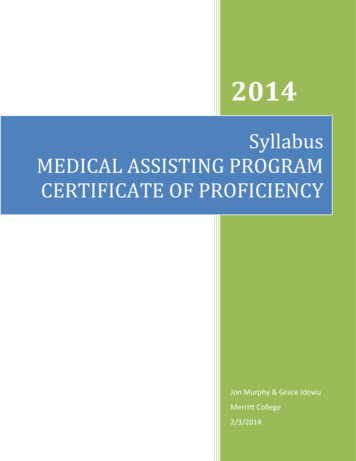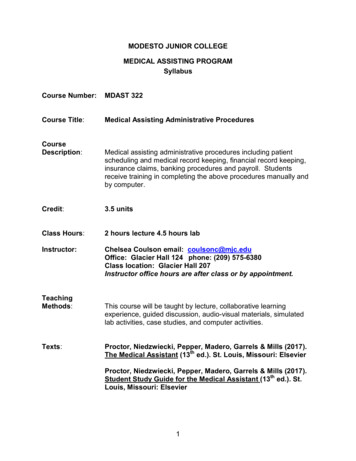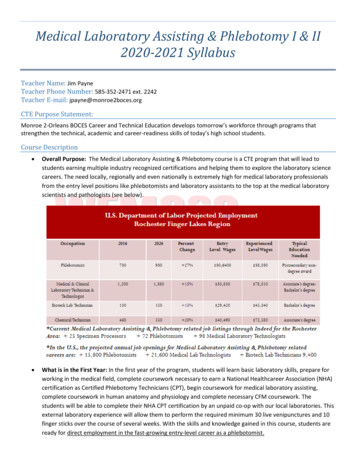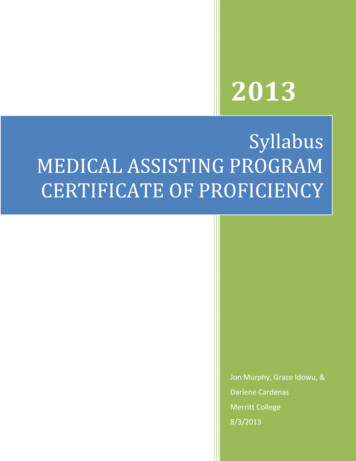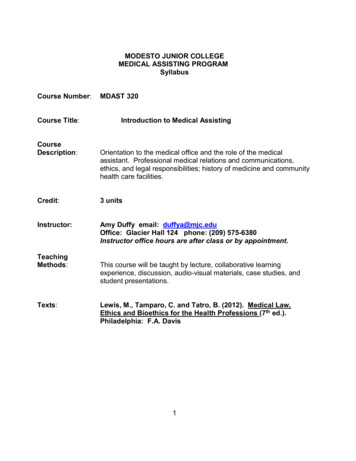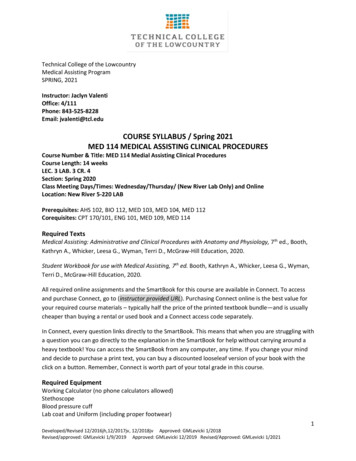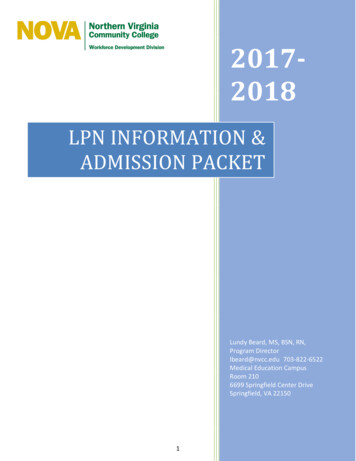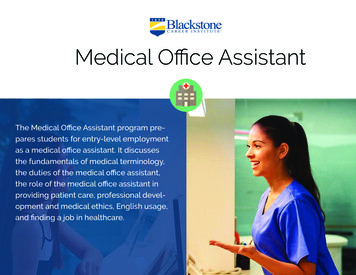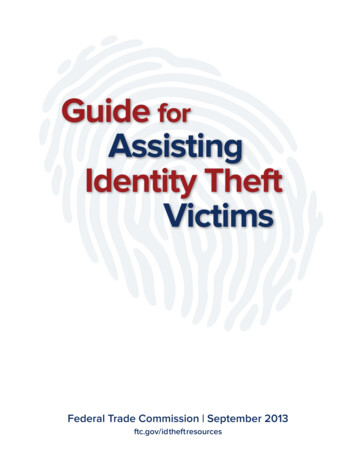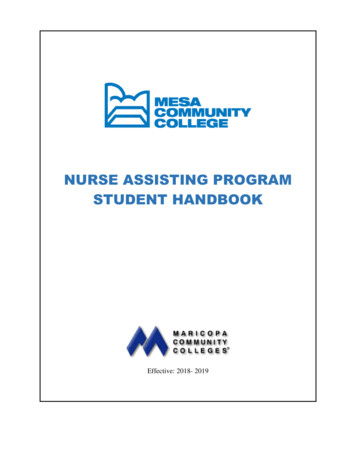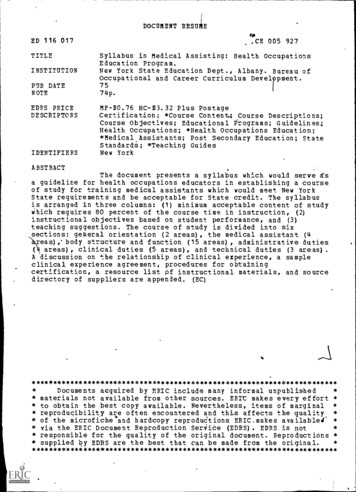
Transcription
DOCUMENT RESUMEtoED 116 017TITLE.CE 005 927PUB DATESyllabus in Medical Assisting: Health OccupationsEducation Program.New York State Education Dept., Albany. Bureau ofOccupational and Career Curriculum Devel pment.75NOTE74p.EDPS PRICEDESCRIPTORSMF- 0.76 HC- 3.32 Plus PostageCertification; *Course Content; Course Descriptions;Course Objectives; Educational Programs; Guidelines;Health Occupations; *Health Occupations Education;*Medical Assistants; Post Secondary Education; StateStandards; *Teaching GuidesNew YorkINSTITUTIONIDENTIFIERSABSTRACT.The document presents a syllabus which would serve Ssa guideline for health occupations educators in establiShing a courseof study for training medical assistants which would meet New YorkState requirements and be acceptable for State credit. The syllabusis arranged in three columns: (1) minimum acceptable content of studyWhich requires 80 percent of the course time in instruction, (2)instructional objectives based on student performance, and (3)teaching suggestions. The course of study is divided into sixsections: general orientation (2 areas), the medical assistant (4reas),-body structure and function (15 areas) , administrative duties(areas), clinical duties (5 areas), and technical duties (3 areas)A discussion on the relationship of clinical experience, a sampleclinical experience agreement, procedures for obtainingcertification, a resource list pf instructional materials, and sourcedirectory of suppliers are appended. **************************Documents acquired by ERIC include many informal unpublished* materials not available from other sources. ERIC makes every effort ** to obtain the best copy available. Nevertheless, items of marginal ** reproducibility are often encountered and this affects the quality ** of the microfiche and hardcopy reproductions ERIC.makes available ** via the ERIC Document Reproduction ser,iiae (EDRS) . EDRS, is not* responsible for the quality of the original document. Reproductions ** supplied by EDRS are the best that can be made from the ******************************
U S DEPARTMENT OF HEALTH,EDUCATION &WELFARENATIONAL INSTITUTE OFEDUCATIONTHIS DOCUMENT HAS BEEN REPRODUCED EXACTLY AS RECEIVED FROMinTHE PERSON OR ORGANIZATION ORIGINATiNG iT POINTS OF VIEW OR OPINIONSSTATED DO NOT NECESSARILY REPRESENT OFF ICIAL NATIONAL INSTITUTE OFEDUCATION POSITION OR POLICYSYLLABUSI2HEALTH OCCUPATIONS EDUCATION PROGRAMMEDICAL ASSISTING1975The University of the State of New York/The State Education DepartmentBureau of Occupational and Career Curriculum/Albany, New York 12234
7619841982THE UNIVERSITY OF THE STATE OF NEW YORKRegents of The University (with years when terms expire).Theodore M. Black, A.B., Litt.D., LL.D., Pd.D., D.C.LChancellor.Sands PointCarl H. Pforzheimer, Jr., A.B., M.B.A., D.C.S., H.H.DViceChancellor-PurchaseAlexander J. Allan, Jr., LL.D., Litt.D.TroyJoseph T. King, LL.B.Shelter IslandJoseph C. Indelicato, M.D.BrooklynFrancis W. McGinley, B.S., J.D., LL.D.Glens FallsKenneth B. Clark, A.B., M.S., Ph.D., LL.D., L.H.D., D.Sc.Hastings on HudsonHarold E. Newcomb, B.A.OwegoWillard A. Genrich, LL.B., L.H.D., LL.D.BuffaloEmlyn I. Griffith, A.B., J.D.RomeGenevieve S. Klein, B.S., M.A.BaysideWilliam Jovanovich, A.B., LL.D., Litt.D. L.H.D.Briarcliff ManorMary Alice Kendall, B.S.IrondequoitJorge L. Batista, B.A., J.D.BronxLouis E. Yavner,New YorkPresident of the University and Commissioner of EducationEwald B. NyquistExecutive Deputy Commissioner of EducationGordon M. AmbachDeputy Commissioner for Elementary, Secondary, and Continuing EducationThomas D. SheldonAssociate Commissioner for Instructional ServicesWilliam L. Bitner IIIAssistant Commissioner for General Education and Curricular ServicesVivienne N. AndersonDirector, Divrsion of Curriculum DevelopmentGordon E. Van IlooftG-.--Ear1 hayChief, Bureau of Occupational and Career CurriculumAssistant Commissioner for Occupational EducationRobert S. SechendorfDirector, Division of Occupational Education InstructionRobert H. BielefeldChief, Bureau of Health Occupations EducationRuth-Ellen Ostler
FOREWORDThe ever-increasing ratio of patients to physicians has created a need for assistants educated to performthose functions of a practice which are not reserved, by law or ethics, to the licensed physician or registeredphysician's associate. In response, a statewide advisory committee was convened in August 1972, to set objectivesand parameters for instruction in medical assistiug. Sitting as the committee, wereMarjorie Barscz, Coordinator of Health Occupations Education, Herkimer BOCESIna Conley, Associate in Health Occupations Education, The State Education DepartmentDominick Eanello, Assistant Dean of Physical and Health Sciences, Hudson Valley Community CollegeHelen Elbert, Teacher of Medical Assisting, Nassau BOCESDorothy Fisk, Coordinator of Health Occupations Education, Oswego BOCESMarilyn Goldman, Teacher of Medical Assisting, Nassau BOCESR. Winifred Johnson, Associate in Health Occupations Education; The State Education DepartmentJoseph J. Messier, Associate in Vocational Curriculum, The State Education DepartmentElton Murphy, Associate in Business EdUcation, The State Education DepartmentRuth-Ellen Ostler, Chief, Bureau of Health Occupations Education, The State Education DepartmentThelma Pottruck, Teacher of Medical Assisting, Suffolk BOCES #3Donald Walker, M.D., The State Health DepartmentKarl S. Wittman, Associate in Health Occupations Education, The State Education Department.Subsequent evaluation of the committee's product led to the decision to select this project as a first experiIn January 1973, G. Earl Hay,ment in local agency development of State curriculum, under Department management.then Supervisor of Vocational Curriculum, Karl S. Wittman, and Mr. Messier met at Nassau BOCES with Frank Wolff,Assistant Superintendent for Occupational Education, and Arthur Side, Supervisor of Occupational Instruction, toeffect a grant-in-aid curriculum development agreement. During the following spring Mr. Messier and Mr. Wittmanmet at intervals with Neil Lash, Curriculum-Coordinator, Nassau BOCES, and Mrs. Goldman, the development teamleader, to guide and evaluate the production of a first draft of content and performance objectives.G. Earl Hay, ChiefBureau of Occupational and Career CurriculumIn September 1973, Mr. Messier presented desired revisions to V. Frank Blasio, Mr. Lash's successor asCurriculum Coordinator, and Edith Tobin, Program Associate for Health Occupations who would chair a writingUnder Mrs. Tobin's leadership, Nassau teachers of Medical Assisting, Helen Elbert, Marilyn Goldman,committee.Barbara Kalfin, and Arlene McCullock, and practicing Medical Assistants Jeanne League and Patricia Robets, revised the first draft and added teaching suggestions and a resource list. The completed manuscript was thenevaluated by Department health occupations, health professions, and curriculum personnel before being preparedby Mr. Messier for printing as this Syllabus in Medical Assisting.Gordon E. Van Hooft, DirectorDivision of Curriculum Developmentiiv
MESSAGE TO TEACHERS AND ADMINISTRATORSThe Health Occupations Education Syllabus in Medical Assisting isastatementoftheminimumcoursecontentacceptable for State credit. A local course,of study basedupon this syllabus should require 21,hourseachdayof 160 teaching days, in each of 2 academic yea's.A program of supervised workexperienceinthemedicalofficeshould be an integral part of the second year of instruction.Where offered, a foundationsorcorecourse inHealth Occupations Educ"ation may be substituted for the broad-base healthoccupationsinstructionof the MedicalAssisting Program. Local courses meeting these standardsofcontentandinstructionalmay grant two creditsper year, for a Group II sequence of four credits, as provided in The Secondary Se'hool timeCurriculum of New YorkState: A Handbook for Administrators.The paramount objective of instruction in Medical Assisting is thatof all occupational educationgraduate employability. Only students evidencing possession ofat least minimum ersonal abilities necessaryto successful employment should be scheduled for instruction in this program.Capable students must not,however, be deprived of academic studies required for admissionto,postsecondary programs leading to licensingor certification in other'health occupations, should such studentsso aspire.The Introduction to this syllabus contains recommendations regardingselectionofteachersandstudents,suggests ancillary studies, and explains the use of the syllabus in developingalocallyeffectivecourse ofstudy.Every director of occupational education, supervisor of occupational instruction,coordinator of occupational curriculum, apd coordinator of a Health Occupations EducationEvery teacher of Medical Assisting should have a personal copy, and program should be familiar with its contents.every guidance office scheduling students for,programs of occupational education should have a reference copy.Ruth7Ellen Ostler, ChiefBureau ofHealth Occupations EducationThe valuable contribution of the advisory committee members,and the Nassau County B.O.C.E.S. developmentand writing teams, in making this syllabus a reality is deeply appreciated.Their enthusiasm for the program,expertise in the field, and sincere effort in developing the contents incooperation with Department personnelhave made this a very practical dociffient for local use.Robert H. Bielefeld, DirectorDivision of Occupational Education Tnstructioniv
FOREWORDGENERAL ORIENTATIONMESSAGE TO TEACHERS AND ADMINISTRATORSINTRODUCTIONSECTION ITHE MEDICAL ASSISTANTThe Health Care IndustryCareer OpportunitiesSECTION IIBODY STRUCTURE AND FUNCTION'Job ProfileInterpersonal RelationshipsPersonal and Patient PsychologyProfessional Ethics and LawSECTION IIIBasic.ComponentsSkeletal SystemMuscular SystemCirculatory SystemRespiratory SystemDigestive SystemUrinary SystemReproductive SystemNervous SystemEndocrine SystemIntegumentary SystemPreventative MedicineRehabilitative MedicineNutrition and Diet TherapyPostnatal 2022232324242425
SECTION IV-- ADMINISTRATIVE DUTIESCLINICAL DUTIESReceptionClericalMedical EconomicsHousekeepingSECTION VTECHNICAL DUTIESAsepsis and SterilizationExamination ProceduresAssisting the PhysicianPharmacologyFirst-AidSECTION VIStandard ProceduresSpecialized TestingOffice TherapyAPPENDIXRelation of Clinical ExperienceSample Clinical Cooperation AgreementProcedure for Obtaining CertificationResource ListSource 4691"-
INTRODUCTION.assisting should be certificated or eligible for certification as aof all, an experienced medical assistant. While the registered oras a medical assistant should prove eminently qualified to teach thethis job experience is not encouraged.This syllabus is the prodUct of the combined knowledge and experience of working medical assistants, andof occupational curriculum specialists and health occupations educators of, both the State Education DepartmentIts content should, then, be of considerable assistanceand several Boarder of Cooperative Educational Services.to established teachers as well as to novices. This introductory section is provided to aid teachers, counselors,administrators, and curriculum coordinatox5, in effective use of the syllabus.THE TEACHERThe teacher of a course in medicalteacher of Medical Assisting, and firstlicensed practical nurse who has workedcourse, employment of a nurse who lacksTHE STUDENTPreparing the student for employment as a medical assistant is the raison dietre of this course. A validsecondary objective is to provide entry-level instruction to students wishing to enter postsecondary study forcertification or licensing in health occupations requiring additional formal education.Employment as a medical assistant requires possession or certain inherent physical, mental, and emotionalattributes in addition to the skills and knowledge developed by instruction. To prevent the waste of funds,and above all, to spare the graduated student probableclass space, teacher effort, and student efforteducators must carefully evaluate the probable employability of prospective students ofdisappointmentIt is no service to the student to schedule for a course in Medical Assisting one who:this course.Has health problems which prevent normal mobilityHas allergies which would adversely affect working with patientsIs uncontrollably overweight to the point where maneuverability in closequarters is adversely affectedLacks manual and digital dexterityLacks normal vision (corrected) in either eye
Cannot hear (corrected) conversation of normal intensity, through atleast one earHas serious speech problemsHas a history of emotional instability, or antisocial behaviorCannot achieve a grade of "medium" or better, on the General AptitudeTests administered by the New York State Department of LaborIt is recommended that a class group contain no more than 24 well-qualified students per teacher, and thatthe clinical experience program be organized on a ratio of 10:1.CONCURRENT OR PREVIOUS STUDYThe schedule of a student who expre:ts the desire to enter postsecondary education in the health field,should be arranged to allow completion of any necessary course work in biology, chemistry, and mathematics.The home-school schedule of the student motivated toward employment as a medical assistant should provideBusiness Education courses in typewriting and recordkeeping, previous to or concurrent with Medical Assistingstudy.In areas where medic 1 offices are not readily accessible through public transportation, drivereducation should be-avac to students of Medical Assisting. Remedial instruction should be provided tostudents entering the course, who do not possess at least tenth grade communication skills.THE SYLLABUSResources and a sourceThis syllabus,is not intended to be used as a course of study. While organized in a logical progression,the content is not in a teaching sequence.The teacher of Medical'Assisting must develop a course of studybased on this syllabus, but sequenced to emphasize local needs and conditions, and reflect that teacher's ownpersonality and selected methodology.A 3-column format was adopted for the syllabus, for clarity and simplicity of use.directory were appended.The first column of the syllabus lists the minimum acceptable content, instruction in wich should requireapproximately 80 percent of the course time, thus allowing addition of content and increased emphases selectedto meet local needs.The second column contains instructional objectives stated in terms of desired student performancearecommended form which simplifies and improves both planning and evaluation. These objectives are written in
the broad, general terms appropriate to a syllabus. They must be rewritten in expanded detail when part of ateacher's course of study, to more specifically define the skills and knowledge necessary to employment.The third column contains suggestions for teaching which should help the experienced medical assistant, whois a novice teacher, to prepare lessons, and should remind the experienced teacher of the course that certainparts of the content, which seem to go without saying, must be fully covered for benefit of the far-frbm-exAl 4 teachers should find this column useful, per se, and as a stimulant to each teacher'sperienced students.own ingenuity and resourcefulness.The appendix lists books, periodicals, catalogs, and specific audiovisuals which are of proven value. TheIt is only one of many sources of information regarding instructionallist is neither exclusive 'nor static.materials to which the teacher should be constantly attuned. Addresses of suppliers are included for theteacher's convenience, as is a sample clinical experience agreement, and the procedure for obtaining certification as a Medical Assistant from the American Association of Medical Assistants Inc.THE COURSE OF STUDYA local education agency which wishes to grant State credit for a co rse in Medical Assisting must keepwhere reasonof the course, oron file a course of study based on this syllabus, prepared by the teachersubmit copy of a nonconforming course o study to the Bureau of Occupational and Careerfor departure existswhether nonconforming or basedCurriculum Development,. for evaluation toward approval. The course of studyshould be developed in cooperation with the local advisory committee.on this syllabusThe teacher, preparing to write a course of study, should first become familiar with the syllabus' contentcolumn, adding any items needed for local effectiveness. The next step should be the realigning of contentIn certain circumstances, with a class group demonstrating appropriateitems into a teaching progression.characteristics, the first lesson may coincide with the f4st content item of the syllabus, a discussion ofGenera,' Orientation." Where a well equipped facility already exists,"Section 1:the "Health Care Industry"Height, Weight,"and students are activity oriented, the first lesson may be "Routine Preliminary DataClinical Duties,"-or any other "hands-on" content which seems most effective. Thelocated in-"Section 5units of content of the syllabus need not remain instructional entities, that is, "General Orientation," forexample, need not be taught in a succession of lessons on this topic exclusively. This content may, instead,be reduced to basic components which can be incorporated into a lesson on content of possibly greater interestFor example, one of the duties of the medical assistant is that of buffer between the physicianto the student.and his patients, colleagues, and subordinate health workers. Role-playing this duty my be a better methodof teaching "Health Team Titles" than would a lesson devoted exclusively to learning titles and theirhierarchical status.It is recommended that course objectives, like the syllabus objectives, be student-oriented. A method ofdevelopment which may be useful is to use the generalized objective of the syllabus as a base, writing as many3T-1
69.truly performance objectives as are necessary to adequately define exactlywhat the student can do, under whatconditions, and to what level of proficiency as a result of the instruction.In the section on "Body Structureand Function," for example, is instruction regarding "Fractures."The syllabus objective states that, "Thestudent should be able to:Describethecharacteristicswhich categorize fractures ,as simple, compound, orgreenstick." When developing this unit for thelocal course of study, the teacher will need to write severaladditional, more specific objectives defining this skill, such as:The student should be able to:Define the general term, "fracture."fracture.Describe the characteristics and symptoms of a simplefracture.Describe the characteristics and symptoms of a compoundfracture.Describe the characteristics and symptoms of a greenstickStudent attainment of these enabling objectives would lead to the culminatingobjective of this instruction,as stated in the syllabus.Completion of objectives for each unit ofcontentwillproduceanacceptablycomplete course of study,but addition of a third column containing miscellaneous notations regardinguse of audiovisuals, identificationof references, and points of emphasis, will be of considerable assistanceto.the teacher when using the courseof study to develop lesson plans.A local course of study developed in this manner serves not onlyto state the breadth of instruction butalso the depth, to clearly define what the instruction is expectedto accomplish, and to provide built-incriteria for evaluation of both the instruction and the instructed.THE LAWThe broad field of health care is ca
The syllabus is arranged in three columns: (1) minimum acceptable content of study Which requires 80 percent of the course time in instruction, (2) instructional objectives based on student performance, and (3) teaching suggestions. The course of study is divided into six sections
